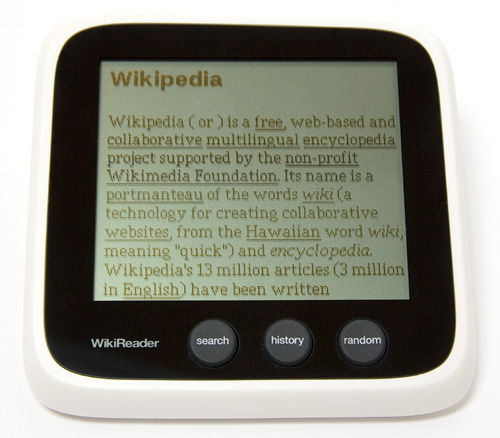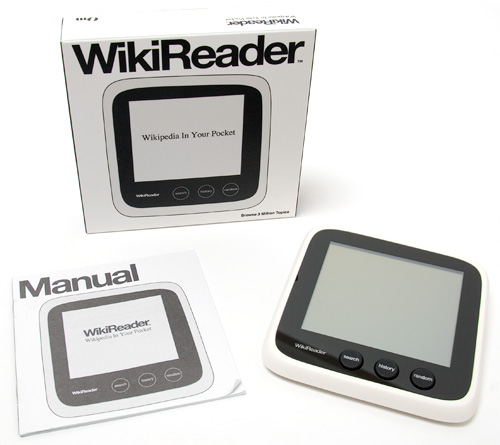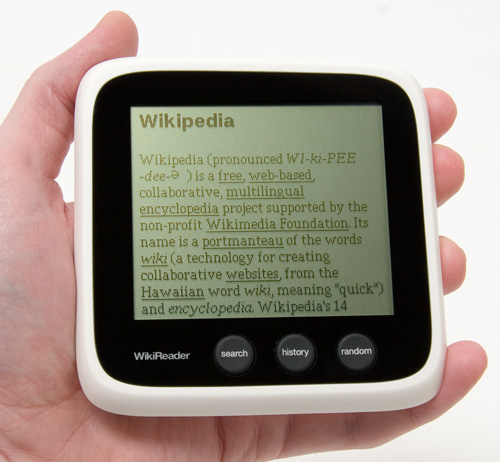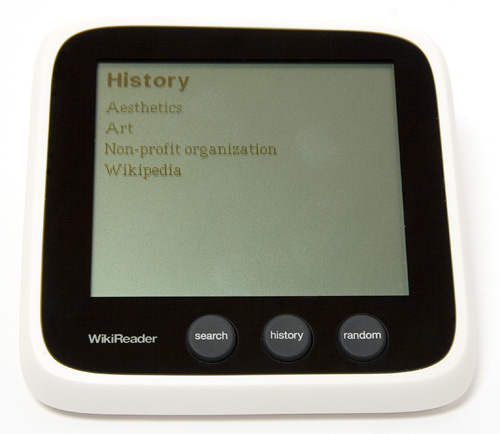
By Andrew Liszewski
When it was first announced last Fall, there wasn’t exactly a lot of enthusiasm for Openmoko’s WikiReader in the gadget blog community. I mean who needs to access an offline copy of Wikipedia on a bare-bones device with a monochrome display, when everything from smartphones to even Amazon’s Kindle can access the online version whenever you need to win a bet or a debate? And the whole purpose of Wikipedia itself is to serve as an always-up-to-date, comprehensive encyclopedia that’s perpetually being expanded. With the WikiReader you only get bi-annual updates to keep its database of over 3 million+ topics current.
But at CES earlier this year, when I actually had a chance to use the WikiReader in person, I have to admit I developed a soft spot for the device. The simplicity of its design and ease of use almost rivals Apple’s obsession with minimalism, and as someone who grew up relying on a shelf full of printed encyclopedias to get through grade school reports, holding the equivalent in the palm of your hand provides one of those ‘look how far we’ve come’ moments. But philosophical musings aside, while I can’t say the WikiReader is a must-have device for everyone, I do think it will appeal to some people. And if you think you might be one of them, please step inside for my full review.

I was pleasantly surprised at how small and basic the packaging for the WikiReader was when it arrived. It definitely mirrors Openmoko’s aim for simplicity. All you really get is the device itself and a brief instruction manual/getting started guide, which isn’t really necessary since the device is so easy to use.

The WikiReader sits easily in one hand, and I’d compare its size to a deck of playing cards, if they were wider and square in dimension. Every corner and angle is rounded so it’s very comfortable to hold, and I’d almost refer to its design as being ‘non-threatening.’
The housing is entirely made from plastic, including the display cover*, but it doesn’t feel cheap. Instead, it makes the WikiReader feel relatively light and simple. The only downside is that the plastic display cover is a lot easier to scratch than one made of glass, which can be problematic when you’re supposed to use it as a touchscreen. Fortunately I haven’t had any major nicks just yet, but I imagine if you were to toss it in a bag with other items it wouldn’t take long for it to get marred.
*Update: It turns out the screen cover is actually made from glass, which is probably why I haven’t suffered any scratches yet. So it should be considerably more durable than I originally thought.

Looking at it from the side, the WikiReader is a little thicker near the top, and this is pretty much due to the set of AAA batteries inside which should keep it running for at least a year. But the added thickness also has the added benefit of providing a slightly more usable reading angle when the WikiReader is sitting on a flat surface.

On the back of the WikiReader you’ll find a battery door where the aforementioned AAA’s are stashed, but nothing else. No warning labels, no technical info, not even a logo. Nice and clean.

Removing the battery door, and the batteries, also reveals where the WikiReader stashes all of those Wikipedia articles. A tiny 8GB microSD card holds the device’s 3 million+ topics, though at the moment it seems like the database only takes up about half of the card’s capacity.
As I mentioned earlier, since Wikipedia itself is constantly being updated, Openmoko is aiming to release updates to the WikiReader’s database twice a year. And so far they’re on track having just released a Spring 2010 update. It’s available for download from the company’s website for free, but since it weighs in at 4.7GB, it’s a hefty download. A torrent link is provided which make things a little easier, but for $29 there’s also the option of having the updates mailed to you on a new 8GB microSD card twice a year. (They don’t ask for the old ones back.)
I’ll be honest, it would be great if the WikiReader was updated on a monthly basis, or even on a more frequent schedule, but the lack of any kind of wireless or hardware connectivity on the device, and the size of the database itself, makes that understandably prohibitive. And the fact that they provide any updates at all still puts it well ahead of other handheld encyclopedias that were once on the market.

In keeping with the WikiReader’s simple design, the device only has 4 hardware buttons. On the top you’ll find the power button which works with a simple ‘push once to turn on’ or a ‘hold for 2 seconds to turn off’ methodology. And it’s got a semi-flush design so it can’t easily be accidentally turned on if the device is bumped.

And just below the display you’ll find the other 3 buttons which are round, rubberized and labeled with ‘search, history & random.’

Hitting ‘search’ brings up an on-screen keyboard and a list of possible entries you’re looking for that’s auto-filled as you type away. Now the limitations of the hardware, like the low refresh-rate of the display, and the fact that it probably isn’t using the latest multi-core processors from Intel, means that the WikiReader isn’t the most blazing piece of electronics I’ve ever used. But it’s still totally usable, and the occasional pause here and there when jumping to or between articles is never an inconvenience. In fact while the monochrome display might look a little dated, it’s still responsive to even the lightest touch, which makes the on-screen keyboard very usable. In fact, the recent Spring 2010 update to the Wikipedia database also came with a handful of improvements to the WikiReader’s UI, including the little pop-up letter you see every time you hit a key, just like on the iPhone.
And like I already mentioned, in the same way that Google creates and narrows down a list of suggestions as you type out your search query, the WikiReader will continually update a list of possible topics underneath your entry to save time if what you’re looking for happens to appear. And when you do find what you’re looking for, you simply have to tap that word to be taken to the specific article.

The articles themselves show up as simple text, with no anti-aliasing due to the WikiReader display’s limited resolution and grayscale capabilities. But while fans of Cleartype will complain that the display is hurting their eyes, no one else should find much to winge about. However, if you’re the type who can’t read a book or an article without pictures, the WikiReader probably won’t appeal to you since none of the images on Wikipedia are included. There is limited image support for displaying mathematical equations as of the Spring 2010 update, but that’s it.

Scrolling a long article is accomplished just as you’d expect it to be on a touchscreen device. You simply touch the display and then drag your finger up or down. Now due to the display’s limited refresh-rate it’s pretty much impossible to read anything while you’re scrolling, but it’s plenty responsive and a lot easier than having to use a set of on-screen scroll buttons.
While browsing an article you’ll also notice there are many words or phrases that are underlined. At one point in time you would have assumed these were phrases being emphasized, but these days an underlined word immediately makes you assume it’s a hyperlink of some sort, and your assumption would be right. And to visit a linked article all you have to do is click on the word to be taken there.

All those underlined words also means you can get lost pretty easily following a link trail on the WikiReader, so hitting the ‘history’ button brings up a complete list of every article you’ve visited, in chronological order. On one hand, quickly jumping back to the previous article isn’t as easy as just hitting a back button, but on the other hand it makes jumping to a specific article you’ve visited, not necessarily the most recent, quite a bit easier. And clearing the history is as easy as holding down the ‘history’ button until a ‘Clear History’ prompt appears, allowing you to choose ‘Yes’ or ‘No.’
Finally, there’s also a ‘random’ button which is probably the single reason I warmed up to the WikiReader in the first place. Hitting it simply brings up one of the 3 million+ articles at random, allowing you to easily fulfill the old ‘you learn something new every day’ adage. I can’t say it’s the single reason why everyone should run out and buy a WikiReader, but it does turn it into a pretty effective and readily available time killer if one was sitting on your desk.
Conclusions:
Now here’s where things get tricky. Overall I think Openmoko has done a really great job at creating a simple piece of hardware with the single intent of providing an easy way to browse Wikipedia’s vast database of articles. Even the most technophobic person should have no trouble figuring out how to use the device without even cracking the included manual, thanks to its simple set of hardware buttons and intuitive touchscreen interface. However, the basic design and minimal functionality that makes the WikiReader easy to use, also serve as its biggest downside. It makes it hard to justify the price.
In a world of highly capable smartphones, with their bright, colorful touchscreen displays, I still think there’s a place for a simple device like the WikiReader, even with its lack of hardware and wireless connectivity, and low-res monochrome display. But the $99 price tag makes it a very tough sell. Now if it was a device from a company like Encyclopedia Britannica which provided access to their private database of articles, I could maybe understand the price since they still charge for their content. But the fact of the matter is that Wikipedia is a ‘free’ resource to anyone with access to a device that can go online, so it’s not like you’re getting anything unique with the WikiReader in terms of content.
If it was priced around $50 (on the high-end) I would definitely be inclined to recommend the WikiReader to anyone who enjoys browsing Wikipedia. But at $99 I think its market is limited to people who’d consider it a last resort for accessing Wikipedia’s vast knowledge base because of a lack of a reliable internet connection.
Pros:
+ Rounded design, minimal buttons and easy-to-use touchscreen UI makes it ideal for technophobes.
+ Bi-annual database updates can also include software updates improving the UI.
+ Updates are provided free if you have the bandwidth to download them.
+ Will probably be the only way to access Wikipedia after the apocalypse.
Cons:
– It’s strictly a consumption-only device. No copying of text or sending article links to a friend.
– Monochrome display with its slow refresh-rate seems a bit dated, though it’s easily readable in daylight.
– Updates to the Wikipedia database are only available twice a year.
– Plastic screen cover will scratch easily.
– $99 is a bit expensive for accessing content you can already get for free online.
Links:
Openmoko WikiReader – $99
If you have any questions about the WikiReader you’d like answered, please feel free to leave them in the comments, and I’ll try to respond to them as best I can.





I like the idea of the wikireader gadget but the practicality of the device is questionable. I just don't see this gadget selling well unfortunately. If I were Openmoko, I would approach Wikipedia with a business join venture plan. Wikipedia buys the gadget at a discounted price and for X ($500?) amount of donation, Wikipedia will give the device to the donator for free as a thank you gesture. Making the gadget an *exclusive* gift from Wikipedia will increase the intrinsic value of the Openmoko wikireader. Otherwise, I just don't see a demand for it.
I think the lack of photos kill it for me. But those that have Wiki ADD, I think will still enjoy it. This review is very impressive I really learned a lot about the product. I do wish you could plug it up and update it constantly.
I think the lack of photos kill it for me. But those that have Wiki ADD, I think will still enjoy it. This review is very impressive I really learned a lot about the product. I do wish you could plug it up and update it constantly.